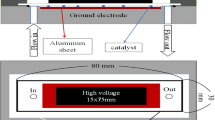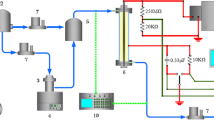Abstract
The present work studied the decomposition of isopropyl alcohol (IPA), widely used in chemical industries and households, in a packed-bed dielectric barrier discharge (DBD) plasma reactor. Metal oxide (MOx) coated on γ-Al2O3 (M = Cu, Mn, Co) was utilized for packing. The plasma-packed mode was a likely alternative to the conventional removal techniques, as it aids the conversion of dilute concentrations of IPA to CO and CO2 at ambient conditions (room temperature and atmospheric pressure). The mean electron energy calculations suggest that electrons with higher energy are generated when the discharge zone is packed with catalysts. When comparing IPA conversion (input concentration of 25 ppm) for no packing mode and MOx/γ-Al2O3 coupled plasma mode, the latter method enhances conversion to greater than 90% at an applied voltage of 18 kV. Also, MOx/γ-Al2O3 showed the highest selectivity to CO2 (70%) compared to plasma-only mode (45%). The metal-oxide layer provides the necessary catalytic surface facilitating the oxidation of IPA to COx through active oxygen species or the interaction of surface hydroxyl groups. The use of MOx/γ-Al2O3 resulted in about 90% carbon balance and reduced ozone generation, demonstrating the significance of integrating metal oxide to achieve efficient conversion and maximal selectivity towards the desired products.








Similar content being viewed by others
References
Bhargavi K, Ray D, Chawdhury P et al (2022) Room-temperature toluene decomposition by catalytic non-thermal plasma reactor. IEEE Trans Plasma Sci 50:1416–1422
Biganzoli I, Barni R, Gurioli A et al (2014) Experimental investigation of Lissajous figure shapes in planar and surface dielectric barrier discharges. J Phys: Conf Ser 550:012039. https://doi.org/10.1088/1742-6596/550/1/012039
Biganzoli I, Barni R, Riccardi C et al (2013) Optical and electrical characterization of a surface dielectric barrier discharge plasma actuator. Plasma Sources Sci Technol 22:025009
Bogaerts A, Tu X, Whitehead JC et al (2020) The 2020 plasma catalysis roadmap. J Phys d: Appl Phys 53:443001. https://doi.org/10.1088/1361-6463/ab9048
Carbone E, Graef W, Hagelaar G et al (2021) Data needs for modeling low-temperature non-equilibrium plasmas: the LXCat project, history, perspectives and a tutorial. Atoms 9:16
Chavadej S, Saktrakool K, Rangsunvigit P et al (2007) Oxidation of ethylene by a multistage corona discharge system in the absence and presence of Pt/TiO2. Chem Eng J 132:345–353. https://doi.org/10.1016/j.cej.2007.01.030
Dors M, Mizeraczyk J (2004) NOx removal from a flue gas in a corona discharge-catalyst hybrid system. Catal Today 89:127–133. https://doi.org/10.1016/j.cattod.2003.11.031
Einaga H, Teraoka Y, Ogat A (2011) Benzene oxidation with ozone over manganese oxide supported on zeolite catalysts. Catal Today 164:571–574. https://doi.org/10.1016/j.cattod.2010.10.067
Eliasson B, Kogelschatz U (1991) Nonequilibrium volume plasma chemical processing. IEEE Trans Plasma Sci 19:1063–1077. https://doi.org/10.1109/27.125031
Hagelaar GJM, Pitchford LC (2005) Solving the Boltzmann equation to obtain electron transport coefficients and rate coefficients for fluid models. Plasma Sources Sci Technol 14:722–733. https://doi.org/10.1088/0963-0252/14/4/011
Jarrige J, Vervisch P (2009) Plasma-enhanced catalysis of propane and isopropyl alcohol at ambient temperature on a MnO2-based catalyst. Appl Catal B 90:74–82. https://doi.org/10.1016/j.apcatb.2009.02.015
Karatum O, Deshusses MA (2016) A comparative study of dilute VOCs treatment in a non-thermal plasma reactor. Chem Eng J 294:308–315. https://doi.org/10.1016/j.cej.2016.03.002
Karuppiah J, Linga Reddy E, Manoj Kumar Reddy P et al (2014) Catalytic nonthermal plasma reactor for the abatement of low concentrations of benzene. Int J Environ Sci Technol 11:311–318. https://doi.org/10.1007/s13762-013-0218-z
Karuppiah J, Sivachandiran L, Karvembu R, Subrahmanyam Ch (2010) Catalytic nonthermal plasma reactor for the abatement of low concentrations of isopropanol. Chem Eng J 165:194–199. https://doi.org/10.1016/j.cej.2010.09.017
Kogelschatz U (2003) Dielectric-barrier discharges: their history, discharge physics, and industrial applications. Plasma Chem Plasma Process 23:1–46. https://doi.org/10.1023/A:1022470901385
Koppmann R Volatile Organic Compounds in the Atmosphere
Leclercq J, Giraud F, Bianchi D et al (2014) Novel inductively-heated catalytic system for fast VOCs abatement, application to IPA in air. Appl Catal B 146:131–137
Liang W-J, Fang H-P, Li J et al (2011) Performance of non-thermal DBD plasma reactor during the removal of hydrogen sulfide. J Electrostat 69:206–213. https://doi.org/10.1016/j.elstat.2011.03.011
Logsdon JE, Loke RA (2000) Isopropyl alcohol. In: Kirk-Othmer encyclopedia of chemical technology. John Wiley & Sons, Ltd
Magureanu M, Mandache NB, Eloy P et al (2005) Plasma-assisted catalysis for volatile organic compounds abatement. Appl Catal B 61:12–20. https://doi.org/10.1016/j.apcatb.2005.04.007
Malik MA, Schoenbach KH, Heller R (2014) Coupled surface dielectric barrier discharge reactor-ozone synthesis and nitric oxide conversion from air. Chem Eng J 256:222–229. https://doi.org/10.1016/j.cej.2014.07.003
Nguyen VT, Yoon KH, Mok YS et al (2022) Practical-scale honeycomb catalytic reactor coupled with non-thermal plasma for high-throughput removal of isopropanol. Chem Eng J 430:132905. https://doi.org/10.1016/j.cej.2021.132905
Pancheshnyi S, Biagi S, Bordage M-C et al (2012) The LXCat project: electron scattering cross sections and swarm parameters for low temperature plasma modeling. Chem Phys 398:148–153
Park M-C, Chang D-R, Woo M-H, et al (1998) Multi-stage pulsed corona discharge system for reduction of NOx emission from diesel engine vehicle. p 982514
Pemen AJM, Chirumamilla VR, Beckers FJCM et al (2018) An SDBD plasma-catalytic system for on-demand air purification. IEEE Trans Plasma Sci 46:4078–4090. https://doi.org/10.1109/TPS.2018.2855402
Pitchford LC, Alves LL, Bartschat K et al (2017) LXCat: an open-access, web-based platform for data needed for modeling low temperature plasmas. Plasma Processes Polym 14:1600098
Qu Z, Bu Y, Qin Y et al (2013) The improved reactivity of manganese catalysts by Ag in catalytic oxidation of toluene. Appl Catal B 132–133:353–362. https://doi.org/10.1016/j.apcatb.2012.12.008
Rani B, Singh U, Chuhan AK et al (2011) Photochemical smog pollution and its mitigation measures. J Adv Sci Res 2:28–33
Reddy EL, Biju VM, Subrahmanyam Ch (2012) Hydrogen production from hydrogen sulfide in a packed-bed DBD reactor. Int J Hydrogen Energy 37:8217–8222. https://doi.org/10.1016/j.ijhydene.2012.02.156
Rivallan M, Fourré E, Aiello S et al (2012) Insights into the mechanisms of isopropanol conversion on γ-Al2O3 by dielectric barrier discharge. Plasma Processes Polym 9:850–854. https://doi.org/10.1002/ppap.201200021
Rodrigues A, Tatibouët J-M, Fourré E (2016) Operando DRIFT spectroscopy characterization of intermediate species on catalysts surface in VOC removal from air by non-thermal plasma assisted catalysis. Plasma Chem Plasma Process 36:901–915. https://doi.org/10.1007/s11090-016-9718-1
Sivachandiran L, Thevenet F, Gravejat P, Rousseau A (2013) Isopropanol saturated TiO2 surface regeneration by non-thermal plasma: influence of air relative humidity. Chem Eng J 214:17–26. https://doi.org/10.1016/j.cej.2012.10.022
Sivachandiran L, Thevenet F, Rousseau A (2015) Isopropanol removal using MnXOY packed bed non-thermal plasma reactor: comparison between continuous treatment and sequential sorption/regeneration. Chem Eng J 270:327–335. https://doi.org/10.1016/j.cej.2015.01.055
Sivachandiran L, Thevenet F, Rousseau A (2014) Regeneration of isopropyl alcohol saturated MnXOY surface: comparison of thermal, ozonolysis and non-thermal plasma treatments. Chem Eng J 246:184–195. https://doi.org/10.1016/j.cej.2014.02.058
Slaughter RJ, Mason RW, Beasley DMG et al (2014) Isopropanol poisoning. Clin Toxicol 52:470–478. https://doi.org/10.3109/15563650.2014.914527
Subrahmanyam Ch, Magureanu M, Renken A, Kiwi-Minsker L (2006) Catalytic abatement of volatile organic compounds assisted by non-thermal plasma. Appl Catal B 65:150–156. https://doi.org/10.1016/j.apcatb.2006.01.006
Subrahmanyam Ch, Renken A, Kiwi-Minsker L (2007) Novel catalytic dielectric barrier discharge reactor for gas-phase abatement of isopropanol. Plasma Chem Plasma Process 27:13–22. https://doi.org/10.1007/s11090-006-9039-x
Suresh Kumar P, Prot T, Korving L et al (2017) Effect of pore size distribution on iron oxide coated granular activated carbons for phosphate adsorption – importance of mesopores. Chem Eng J 326:231–239. https://doi.org/10.1016/j.cej.2017.05.147
Tu X, Whitehead JC, Nozaki T (eds) (2019) Plasma catalysis: fundamentals and applications. Springer International Publishing, Cham
Urashima K, Chang J-S (2000) Removal of volatile organic compounds from air streams and industrial flue gases by non-thermal plasma technology. IEEE Trans Dielect Electr Insul 7:602–614. https://doi.org/10.1109/94.879356
Vandenbroucke AM, Morent R, De Geyter N, Leys C (2011) Non-thermal plasmas for non-catalytic and catalytic VOC abatement. J Hazard Mater 195:30–54. https://doi.org/10.1016/j.jhazmat.2011.08.060
Wang C-H (2004) Al2O3-supported transition-metal oxide catalysts for catalytic incineration of toluene. Chemosphere 55:11–17. https://doi.org/10.1016/j.chemosphere.2003.10.036
Wang Y, Craven M, Yu X, et al Plasma-enhanced catalytic synthesis of ammonia over a Ni/Al2O3 catalyst at near-room temperature: insights into the importance of the catalyst surface on the reaction mechanism
Whitehead JC (2019) Plasma-catalysis: is it just a question of scale? Front Chem Sci Eng 13:264–273. https://doi.org/10.1007/s11705-019-1794-3
Whitehead JC (2016) Plasma–catalysis: the known knowns, the known unknowns and the unknown unknowns. J Phys d: Appl Phys 49:243001. https://doi.org/10.1088/0022-3727/49/24/243001
Yao S, Zhang H, Shen X et al (2018) A novel four-way plasma-catalytic approach for the after-treatment of diesel engine exhausts. Ind Eng Chem Res 57:1159–1168. https://doi.org/10.1021/acs.iecr.7b04166
Zaman F, Pervez A, Abreo K (2002) Isopropyl alcohol intoxication: a diagnostic challenge. American Journal of Kidney Diseases 40:e12.1-e12.4. https://doi.org/10.1053/ajkd.2002.34938
Zhu T, Wan YD, Zhang CH, et al (2011) VOCs decomposition using multiple catalysis in non-thermal plasma processing. In: Advanced Materials Research. Trans Tech Publ, pp 973–977
Acknowledgements
The authors are grateful to DST-SERB, India, for providing the research fellowship.
Funding
This work was supported by DST-SERB, India (EMR/2016/005636), and UAY (IITH_007).
Author information
Authors and Affiliations
Contributions
Bhargavi Kandukuri: conceptualization, investigation and formal analysis, and writing original draft. Supriya Das: investigation and formal analysis. Umamaheswara Rao Mudadla: investigation and formal analysis. Giridhar Madras: conceptualization and investigation. Shashidhar Thatikonda: funding acquisition and project administration. Subrahmanyam Challapalli: funding acquisition and project administration, writing, review, editing, and supervision.
Corresponding author
Ethics declarations
Ethics approval
Not applicable.
Consent to participate
Not applicable.
Consent for publication
Not applicable.
Competing interests
The authors declare no competing interests.
Additional information
Responsible Editor: Guilherme Luiz Dotto
Publisher's Note
Springer Nature remains neutral with regard to jurisdictional claims in published maps and institutional affiliations.
Supplementary Information
Below is the link to the electronic supplementary material.
Rights and permissions
Springer Nature or its licensor (e.g. a society or other partner) holds exclusive rights to this article under a publishing agreement with the author(s) or other rightsholder(s); author self-archiving of the accepted manuscript version of this article is solely governed by the terms of such publishing agreement and applicable law.
About this article
Cite this article
Kandukuri, B., Das, S., Mudadla, U.R. et al. Non-thermal plasma mitigation of low concentration of air pollutants: removal of isopropyl alcohol using transition metal-oxide integration. Environ Sci Pollut Res (2024). https://doi.org/10.1007/s11356-024-32569-7
Received:
Accepted:
Published:
DOI: https://doi.org/10.1007/s11356-024-32569-7




